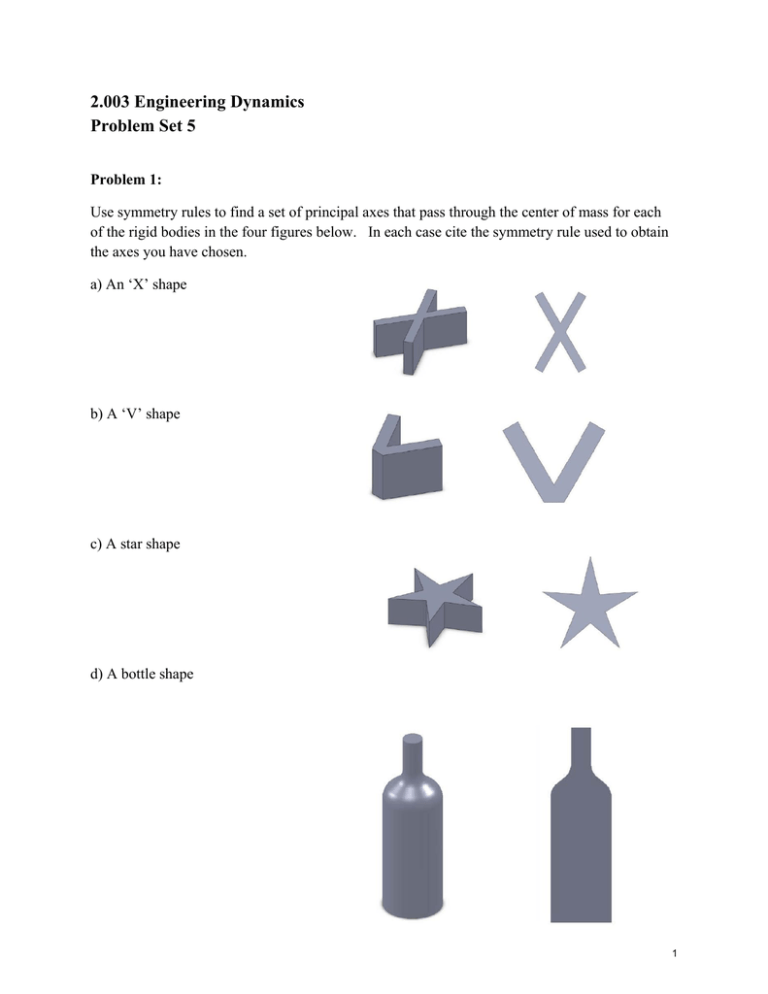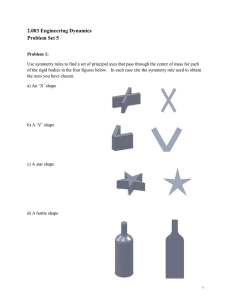2.003 Engineering Dynamics Problem Set 5
advertisement

2.003 Engineering Dynamics Problem Set 5 Problem 1: Use symmetry rules to find a set of principal axes that pass through the center of mass for each of the rigid bodies in the four figures below. In each case cite the symmetry rule used to obtain the axes you have chosen. a) An ‘X’ shape b) A ‘V’ shape c) A star shape d) A bottle shape 1 Problem 2: A block of mass M is constrained by rollers to motion in the x direction. A small mass m is attached at point B to the end of a massless rigid arm. The other end of the arm is attached at a point A which is fixed to the cart. Together the arm and mass make up a rotor which rotates about an axis fixed at A to the cart. The angle the arm makes with a horizontal reference passing through A is given by (t ) t . The length of the arm is ‘e’, the distance from A to B. The position of the cart in the inertial frame is given by the coordinate xiˆ . In Problem Set 3 we found the forces that the arm must exert on the mass, m, to cause it to move in a circular path about point A. These forces may be expressed as: Frod m[ x e 2 cos( )]iˆ m[ g e 2 sin( )] ˆj a. Find an equation of motion of the cart by using Newton’s third law to express the forces of the rod on the cart of mass M. Concept question: Given that 1.0 radians/second, the parameter (t ) is not an independent coordinate, but a specified quantity, known for all time, how many independent coordinates are required to completely describe the motion of the system? (a)1 (b)2 (c)3 (d)4 Problem 3: Two identical masses are attached to the end of massless rigid arms as shown in the figure. The vertical portion of the rod is held in place by bearings that prevent vertical motion, but allow the 2 shaft to rotate without friction. The shaft rotates with angular velocity with respect to the Oxyz inertial frame. The arms are of length L. The frame Ax1y1z1 rotates with the arms and attached masses. Note that the angle is fixed. a) Compute the angular momentum for this two-mass system with respect to point A. b) Express the angular velocity (t ) of the rotating system as a vector using unit vectors in the rotating Ax1y1z1 frame. c) Express H / A = I , where I is a 3 x1 × 3 matrix and y1 . z1 d) Compute dH / A where you should note dt that is not assumed to be constant). x iˆ1 e) Find the torque about A and express it as a vector / A y ˆj1 , where iˆ1 , ˆj1 , and kˆ 1 are unit ˆ z k1 vectors in the rotating Ax1y1z1 system. f) Where could you place a single additional mass, connected to a massless arm, such that dH / A dt would yield torque with a component only aligned with the z direction? Concept question: What is the nature of the imbalance of this system: A) static, B) dynamic, C) static and dynamic. 3 Problem 4: A motorized cart is carrying a box of mass m = 800 kg on its flat bed. The static coefficient of friction between the cart’s bed and the box is µs=0.3. The center of mass of the box is 1.0m above the bed of the cart. The length of the box is 2b=0.2m and the center of mass of the box is located at a distance b=0.1 m from the edge of the crate. The cart is travelling on a level floor and gravity is at work. a) Find the maximum horizontal acceleration of the cart that does not cause the box to slip nor tip. Concept question: Is it necessary to know the mass moments of inertia for the box to solve this problem? (a) yes (b) no. Problem 5: A pendulum consists of a rectangular plate (of thickness t) made of a material of density , with two identical circular holes (of radius R). The pivot is at A. a) Find the location of C, the center of mass of the pendulum. I and I zz / A the b) Compute zz / C mass moments of inertia about C and A respectively with respect to the z axis. Note: you can use the tables for Izz/C given in many textbooks for various shapes. c) Derive the equations of motion for the system. (Note: do not assume small motions) 4 Concept question: Is the mass moment of inertia of a plate with respect to the center of mass at C as shown in the figure above equal to the sum of the mass moments of inertia with respect to the same point C for the plate with holes and the mass moment of inertia of the material removed to make the holes. A) Yes, b) No. Problem 6: Two uniform cylinders of mass m1 and m2 and radius R1 and R2 are welded together. This composite object rotates without friction about a fixed point O. An inextensible massless string is wrapped without slipping around the larger cylinder. The two ends of the string are connected to the ground via, respectively, a spring of constant k and a dashpot of constant b. The smaller cylinder is connected to a block of mass mo via an inextensible massless strap wrapped without slipping around the smaller cylinder. The block is constrained to move only vertically. a) Draw a free body diagram for the system. b) Derive the equations of motion for the system. Concept question: How many independent coordinates are required to completely describe the motion of the system? a)1, b)2, c) 3, d)4 . Problem 7: A wheel is released at the top of a hill. It has a mass of 150 kg, a radius of 1.25 m, and a radius of gyration of kG =0.6 m. a) If the coefficients of static and kinetic friction between the wheel and the plane are µs =0.2 and µk =0.15 respectively, determine the maximum angle, , of the inclined plane so that the wheel rolls without slipping. Concept question: If the tire begins with zero speed and travels down the hill, will it get to the bottom faster if there is always slip, or if there is no slip? a) Faster with slip, b) Faster with no slip. Or c) Doesn’t matter. 5 MIT OpenCourseWare http://ocw.mit.edu 2.003SC / 1.053J Engineering Dynamics Fall 2011 For information about citing these materials or our Terms of Use, visit: http://ocw.mit.edu/terms.




